|
[Front Page] [Features] [Departments] [Society Home] [Subscribe]

Alyogyne: An Update
Colleen Keena
Note: The "P" and "W" links in the text refer respectively to the printed material ("P") and material on the web ("W") listed in the "References" section.
Introduction
Alyogyne species were featured in the "Australian Plants" journal in 1966 (P1). The author, Paul A. Fryxell, wrote that "this wholly Australian genus includes two or more shrubby species with showy flowers". He described two of these in detail, one of which was Alyogyne hakeifolia.
However, this was not the first mention of these plants. Specimens of what is now known as Alyogyne hakeifolia were collected in 1802 by Robert Brown. One of these is held in the National Herbarium of New South Wales. Alyogyne hakeifolia is one of the watercolours from a sketch in 1803 which is included in the drawings of Ferdinand Bauer in "An Exquisite Eye" (P2). At this time, the plant was known as Hibiscus filifolius. At the time of writing, a section of this illustration can be seen online.
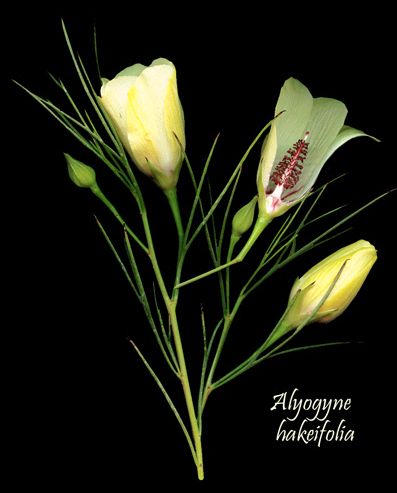 |
|
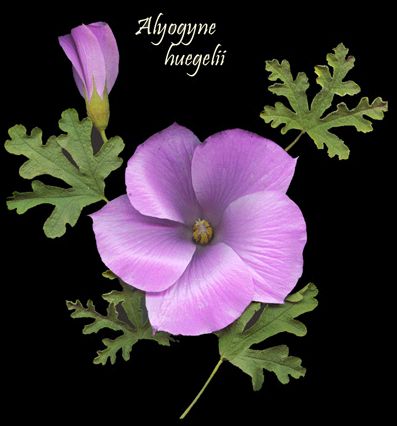 |
|
| Photos: © Gil Bujanda |
|
Alyogyne hakeifolia was again illustrated, this time under the name of Hibiscus multifidus. It appeared in Paxton's Magazine of Botany in 1839 and can also be seen online currently. It has also been known as Hibiscus hakeifolius, Cienfuegosia hakeifolia, Fugosia hakeifolia and as Alyogyne lilacina. Plants were grown in England in the early half of the 19th century.
The other species described in detail in 1966 was Alyogyne cuneiformis which had previously been known as Hibiscus cuneiformis and also as Cienfuegosia cuneiformis and Fugosia cuneiformis. Plants of this species were also cultivated in England in the 19th century (P1). Alyogyne cuneiformis can be seen online.
Following the article on Alyogyne in Australian Plants in 1966, there was an article entitled "More Hibiscus" by R.L.Hill (P3). One of the shrubs described was Hibiscus huegelii. As well as describing the species which has either deep mauve or pure white blooms, the deep mauve-pink flowers of var. leptochlamys were noted. Hibiscus huegelii had been illustrated in 1848 as Hibiscus grossulariaefolius and is currently online under that name. However, in 1968 it became known as Alyogyne huegelii.
Another plant, Alyogyne pinoniana, formerly known as Hibiscus pinoniana, became Alyogyne pinoniana in 1968 (W1). This species can be seen by searching for Alyogine pinoniana at the WA Herbarium FloraBase. This plant was illustrated in Australian Plants, Vol. 10:49.
In 1987, Alyogyne cravenii was added to the genus Alyogyne (W2).
This brings to five the number of species at present in Alyogyne. References for the plants currently in Alyogyne can be found at the Australian Plant Name Index (search for Alyogyne). There is a summary of these species and their references in the reference section.
Obviously there have been considerable changes to the names of plants currently included in Alyogyne. Any update needs to show not only species currently included but also any proposed changes and Dr John Conran will be foreshadowing changes to Alyogyne in a future article.
Difference between Alyogyne and Hibiscus
All the current species of Alyogyne, except for A. cravenii, were previously included in Hibiscus. Alyogyne is distinguished from Hibiscus by the flowers having a style which is undivided to the stigmas, while in Hibiscus the style is branched to below the stigmas. Alyogyne is from the Greek alytos, united, undivided, and gyne, woman, ovary, alluding to the undivided style (P4, W5).
In the 1966 paper, P.A. Fryxell (P1) noted that "Alyogyne may be distinguished from Hibiscus by its characteristic six-toothed involucel, its semi-stipitate calyx, and its clavate style with decurrent stigmatic lobes". He continued that in addition, the embryo is quite small and much simpler than that typical of Hibiscus and is completely enclosed by a well-developed endosperm, a tissue that is much reduced in Hibiscus.
Horticultural advantages of Alyogyne
Alyogyne have a number of characteristics that make them of horticultural value. They exhibit the rapid growth of Australian Malvaceae species but have several advantages over other Malvaceae species such as Hibiscus. The blooms usually last more than a day, in contrast to Australian species of Hibiscus which only last one day. There are none of the prickles associated with Hibiscus species such as H.heterophyllus and also they are less likely to cause allergic reactions than species with irritant hairs such as Lagunaria patersonii (Norfolk Island Hibiscus). As well, the large blooms not only blend with exotics but are valued by gardeners who may not otherwise choose to grow a native plant. The flowering is profuse, often beginning in the first year.
Alyogyne huegelii has been described by John Hunt (P5) as an example of an 'anywhere' plant. He describes 'anywhere' plants as plants that can be used quite freely throughout the garden, for they occupy little or no space, remaining unseen for most of the time, but they flower magnificently and are very showy at particular times of the year. He notes that Alyogyne huegelii is normally a straggly plant but, if kept pruned and grown in between and among other plants, it will enhance any garden setting, adding an indefinable charm at spring time. He continues that 'anywhere' plants create that 'old English cottage garden' effect by sprinkling a magical continuity of colour and vitality throughout the garden.
Distribution of Alyogyne
Species of the genus are distributed in Western Australia, Southern Australia and the Northern Territory. Maps showing the distribution of specimens of each of the five currently recognised species are shown on the Australian Plant Name Index site (search for Alyogyne). A map showing all the species is shown on the Alyogyne Page by Stewart Robert Hinsley.
Alyogyne around the world
Although it originated in Australia, Alyogyne is currently being grown not only in Australia, but also in Europe, USA and New Zealand.
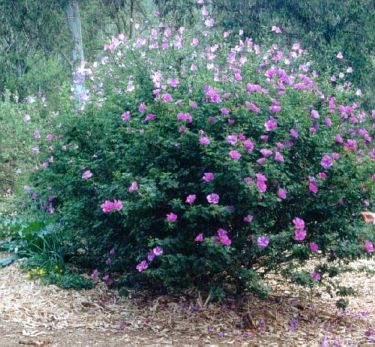 |
|
Alyogyne huegelii 'Swan River' or 'West Coast Gem'
Photo: © Geoff Keena |
|
In Australia, the two species most readily available are Alyogyne huegelii and A.hakeifolia. Species and cultivars of both A.huegelii and A.hakeifolia are available. Cultivars of A.huegelii include 'West Coast Gem', which has deep purple blooms with overlapping petals on an open rounded bush. A fragrant pink tulip-shaped bloom was released as A.huegelii 'Southern Cross Hibiscus' but it is now sold as A.huegelii pink. A pink-flowering cultivar of A.hakeifolia is available as 'Melissa Anne' and a yellow-flowered form as 'Elle Maree'.
In Europe, the Alyogyne which is most readily available is the 'blue' form of Alyogyne huegelii, still sometimes known as 'Blue Hibiscus'. Jean-François Giraud (W7), who lives in France, notes that A.huegelii is cultivated by Dutch, Spanish and Italian producers and is grown more rarely in France. He continues that it is sold in 12 to 20 cm pots, as a small flowering plant, sometimes with more than one cutting in the pot, and in Holland as a standard. Jean-François grows A.hakeifolia but says that it is difficult to find in Europe, with only the mauve form being currently available. Both A.huegelii and A.hakeifolia are mentioned on websites of plants in the UK.
In the USA, a number of cultivars of A.huegelii are grown. Four cultivars, with interesting background information, are shown at the Monterey Bay Nursery Inc website. One is white and the others are shades of purple. There is a light purple, 'Santa Cruz', a dark purple, 'Monterey Bay' (probably equivalent to 'Mood Indigo,' and also sold as 'Purple Haze') and a medium blue purple, 'Swan River'. This is the same cultivar as the plant known as 'West Coast Gem' in Australia. The UCSC Arboretum used A.huegelii 'Moora' with seedlings from 'Moora' as parents and did a number of back crosses. The flowers have a conspicuous overlapping "propeller" form. Both leaves and petals seem to have a heavier substance than most other varieties.
Alyogyne hakeifolia is available in either lavender or yellow.
The 'blue' form of Alyogyne huegelii is grown in New Zealand.
Species commonly grown
As Alyogyne huegelii and A.hakeifolia are the two species most commonly grown and most readily available, both in Australia and overseas, these will be the focus of this article.
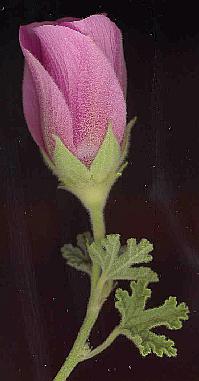 |
|
Alyogyne huegelii: pink form (Hibiscus huegelii var leptochlamys)
Photo: © Geoff Keena |
|
Prior to Hibiscus huegelii being transferred to Alyogyne, there were a number of varieties recognised, e.g. Hibiscus huegelii var. wrayae and H.huegelii var. leptochlamys (W1: APNI, search for Hibiscus huegelii). Although since the move to Alyogyne, these varieties have no current formal taxonomic standing, not having been recognised by Fryxell, most of the forms, including cultivars, in cultivation both in Australia and overseas, are either what was previously H.huegelii var wrayae, with open flowers, yellow anthers and blooms which are very variable in colour and size, or what was previously H.huegelii var. leptochlamys.
As already mentioned, H.huegelii var. leptochlamys was described in Australian Plants in 1966 (P2). The description noted that it is a more compact grower with large flowers and that it is a lovely plant that deserves a place in our gardens. There are photos with that article of a pink form and a mauve form, both with tulip-shaped blooms, of what was previously H.huegelii var. leptochlamys but is currently included in Alyogyne huegelii.
The other species which is most readily available is Alyogyne hakeifolia. It is more difficult to grow in countries like France than A.huegelii (W3) and is less popular with buyers in USA (W4) when there is a choice of both A.huegelii and A.hakeifolia. It is less hardy than A.huegelii in climates such as the subtropics with wet summers. However, the unusual foliage, a feature even when the plant is not in bloom and the flowers, described by Jean-François Giraud (W3) as "exquisite, fine and delicate" make this a plant worth trying.
Of the three other species currently included in Alyogyne, it is difficult to obtain seed or plants of either A.cuneiformis or of A.pinoniana. A.cravenii is apparently actually a member of Hibiscus (Lyn Craven pers. comm. P6) and as such not covered here.
Description of species
Alyogyne hakeifolia
A.hakeifolia (P7) is normally an upright, much-branched, rapidly growing small to medium shrub reaching to 3 m (10'). The leaves are dark green, glabrous, comprised of very narrow linear segments, 5-10 cm (2-4") x 0.1-0.2 cm ( to 1/8"). The individual lobes of the leaves make the foliage 'needle-like'.
The plant produces an abundance of blooms each season. There are mauve, yellow and pink forms. The plant blooms from November until March. The blooms are 5-6 cm (1"-2 1/2") long, tubular in shape, not opening widely and they usually have a dark red central spot. The capsule is 1.8-2 cm (3/4") x 1.2 cm (1/2") and is 5-celled.
It is a desert shrub which occurs in South Australia and in the southern part of West Australia (P1).
Alyogyne huegelii
 |
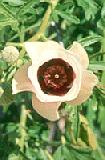 |
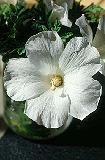 |
Alyogyne huegelii
left, mauve form (Hibiscus huegelii var leptochlamys)
centre, yellow form
right, white form (Hibiscus huegelii var wrayae)
Photos: © Gil Bujanda, John Conran |
A.huegelii (P7) is an open, rapidly growing medium-sized shrub reaching about 2.5 m (8') in height and almost equal breadth. The leaves are 2-7 cm (3/4"-3")long, bright green and deeply lobed into 3-5 segments. The segments are blunt, the margins are irregularly toothed and lobed.
This plant can produce hundreds of blooms each season. The plant blooms from October until March and can also bloom sporadically. The flowers are 7-10 cm (3- 4") and last 1 - 2 days and can be yellow, white, lilac, pink, mauve or deep purple. The ovoid capsule is about 2 cm (3/4") across.
The yellow form was described in Australian Plants in March 1965 (Vol. 3:58). It was described as making a dense shrub to 6' with soft yellow, red throated flowers of the same size and shape as the blue Cienfugosia hakeafolia (Alyogyne hakeifolia), and flowering for six months during the warmer periods of the year.
It is found naturally in sandy to sandy-gravel areas of South Australia and Western Australia.
Cultivation
Alyogyne hakeifolia
As A.hakeifolia (P7) is a desert plant, it is well suited to a warm, dry climate. It is intolerant of bad drainage but is adaptable and sufficiently hardy in cool moist climates such as south-eastern Australia. A well-drained sunny spot is ideal although plants will grow in semi-shade. Plants perform best when they receive sunlight for most of the day and have some wind protection as large plants are subject to wind damage.
The plant may develop into a well-shaped shrub without any need for pruning but it can be pruned to improve the shape if desired.
A.hakeifolia tolerates mild frosts but some protection may be required from heavier frosts.
Alyogyne huegelii
As A.huegelii (P7) comes from sandy to sandy-gravel areas, it is also intolerant of bad drainage however it is adaptable to a wide range of soil types. A well-drained sunny spot is ideal although plants will grow in semi-shade. Plants perform best when they receive sunlight for most of the day and have some wind protection as large plants are subject to wind damage.
| |
 |
| |
Alyogyne huegelii; Lilac form
(Hibiscus huegelii var wrayae)
Photo: © Geoff Keena |
The plant becomes straggly unless pruned regularly. After the main flowering flush in late spring the shrub can be pruned back quite hard to ensure stronger growth and increase its longevity and flowering life. A.huegelii tends to become a little sparse of foliage on lower limbs if left completely unpruned. This species has the desirable ability to throw out vigorous, fast-growing shoots from old wood, thus enabling it to be kept down to a small compact shrub if desired. Heavy pruning can maintain its size in relation to other plants. Luen Miller from Monterey Bay Nursery in California (W3) reports that plants that were browsed by deer in drought conditions developed into dense, thick, dome-shaped plants about 1.5 m (5') tall and 2.4 m (8') across and were completely covered with purple flowers.
A.huegelii is moderately frost tolerant but some protection is required from the heaviest frosts. Experience at Monterey Bay Nursery in California (W3) indicates that it will probably be cut to the ground by -4ºC (25°F) for more than a single night.
Cultivation of both Alyogyne hakeifolia and Alyogyne huegelii
Alyogyne species usually grow well without fertiliser, particularly if well mulched with a mulch that breaks down and provides nutrients. However, if a fertiliser is needed, for example when raising seedlings, use of a seaweed extract has been found to be beneficial. Many Australian plants are sensitive to phosphorus as they have developed in nutrient-deficient soils. Alyogyne hakeifolia and A.cuneiformis are least sensitive to phosphorus whereas A.huegelii is highly sensitive. Further information is available in an Australian Plants online article on phosphorus sensitivity by Kevin Handreck.
Plants grown in well-mulched beds require minimal, if any, supplementary watering once established. When plants are being established, they are watered well at planting, then again in the middle of that first week, then a week later, then a fortnight later, and if needed, then a month later. When established in this way, they should only need supplementary watering under extremely dry conditions. Plants will however take regular watering provided that they are in a well-drained position.
 |
|
Alyogyne huegelii 'Mood Indigo'
Photo: © Gil Bujanda |
|
Of course, gardeners who wish to grow A.huegelii and A.hakeifolia but do not have the right growing conditions such as a well drained sunny spot, can grow them in pots. In a container, both species not only flourish but even set seed when grown in 15 cm (6") pots. Maintaining them in such small pots would require ongoing care and potting on to larger containers would be advisable. An example of Alyogyne huegelii grown in a large container can be seen on a European website.
Alyogyne is usually not troubled by pests although it may act as the host plant for pests such as Harlequin Bugs (Dindymus versicolor) (P8). If pests are present, e.g. scale or mealybug, pruning may be sufficient to control them.
Propagation
Alyogyne huegelii and A.hakeifolia are easily propagated from both seed and cuttings. The species is easy to grow from seed but cultivars would need to be propagated from cuttings to maintain the characteristics of the parent plant.
Seed of both species may keep its viability for a number of years. Treatment which will break through the hard protective coating and allow moisture to penetrate is recommended. Germination will be much faster after treatment. Seeds can be abraded with an emery board, or a slight nick can be made while the seed is being held with tweezers. As well, seeds can be soaked in warm but not boiling water, with water being changed every day until the seeds start to swell. Time of planting seed would depend on where the plant is being grown. In areas with harsh winters, it would be preferable to plant seed in spring. In places with very wet summers and mild winters, seed can be planted in early autumn.
Seed of both A.huegelii and A.hakeifolia has been reported to be responsive to smoke treatment.
Alyogyne may also be grown from cuttings, which strike easily. Cuttings can be half-hardened tip cuttings 7-8 cm (3") long, although soft tip cuttings also do well. Again, the time of taking cuttings would vary according to location. Cuttings taken in spring generally establish well but cuttings can be taken in early autumn if summers are very wet and winters are not too severe. Treatment with a preparation to enhance root formation may be beneficial.
Availability
In Australia, both seeds and plants are available from suppliers of native plant seeds and nurseries which include native plants in their species list. Searching for Alyogyne huegelii or Alyogyne hakeifolia on the internet can give information on suppliers of seed and plants for Europe and USA.
Conclusion
It is 200 years since the beauty of Alyogyne hakeifolia was depicted by Ferdinand Bauer. Species are currently available in Europe and both species and cultivars are grown in USA. It is hoped that this article will not only ensure accurate identification but hopefully highlight the "distinct horticultural possibilities" noted in Australian Plants in 1966 (1).
References
Printed Material
- Fryxell, P.A. (1966), Australian Plants: 16-18 (17-18)
- Watts, P. Pomfrett, J. Mabberley, D. (1997), An Exquisite Eye : the Australian Flora and Fauna Drawings 1801-1820 of Ferdinand Bauer. Historic Houses Trust of New South Wales, Glebe, NSW. Alyogyne hakeifolia, page 50.
- Hill, R.L. (1966), Australian Plants: 19-20
- Canberra Botanic Gardens, Growing Native Plants (1976), Vol. 6: 137, page 137
- Hunt, J.M. (1986) Creating An Australian Garden, Kangaroo Press in association with The Society for Growing Australian Plants-NSW Ltd., NSW, pages 74-77.
- Craven, Lyn. Australian National Herbarium Centre for Plant Biodiversity Research, Canberra ACT 2601. Personal communication.
- Elliot, W.R. and Jones, D.L. Elliot, W.R. and Jones, D.L. (1982,1985) Encyclopaedia of Australian Plants Suitable for Cultivation, Vol. 2, Lothian Publishing Co., Port Melbourne, pages 181-182.
- Jones, D.L. and Elliot, W. R. (1986, 1989,1990) Pests, Diseases and Ailments of Australian Plants, Lothian Publishing Co., Port Melbourne, pages 48-49.
On the Web (Links current as of 30 June 2002)
- Alyogyne species in Australian Plant Name Index (search for Alyogyne) :
- Alyogyne cravenii Fryxell Fryxell, P.A. (1987), Systematic Botany 12: 277, fig. 3
- Alyogyne cuneiformis (DC.) Lewton Fryxell, P.A. (1966), Australian Plants: 16-18 (17)
- Alyogyne hakeifolia (Giord.) Alef. Fryxell, P.A. (1966), Australian Plants: 16-18 (17-18)
- Alyogyne huegelii (Endl.) Fryxell Fryxell, P.A. (1968), Proceedings of the Linnean Society of New South Wales 92(3): 265
- Alyogyne pinoniana (Gaudich.) Fryxell Fryxell, P.A. (1968), Proceedings of the Linnean Society of New South Wales 92(3): 265
- Australian National Botanic Gardens: Text by ANBG staff (1976) Alyogyne huegelii
- Jean-François Giraud: notes on Alyogyne in Europe, personal communication
- Monterey Bay Nursery and Luen Miller: notes on Alyogyne in USA, personal communication
The author wishes to thank Dr John Conran (Dept of Environmental Biology, The University of Adelaide SA 5005), Marcos Capelini (Some Malvaceae in Brazil), Jean-François Giraud (Merveilleux Hibiscus), Stewart Robert Hinsley (The Alyogyne Page), Brett Hall (The UCSC Arboretum), Luen Miller of Monterey Bay Nursery Inc for their assistance and Gil Bujanda for his images of Alyogynes in his garden in California, USA.

[Front Page] [Features] [Departments] [Society Home] [Subscribe]
Australian Plants online - December 2002
Association of Societies for Growing Australian Plants
|